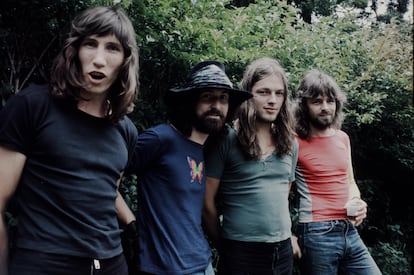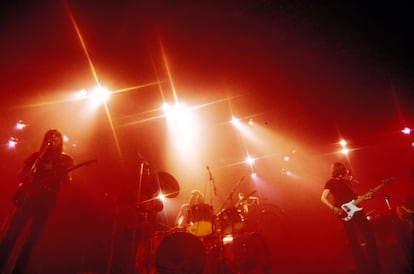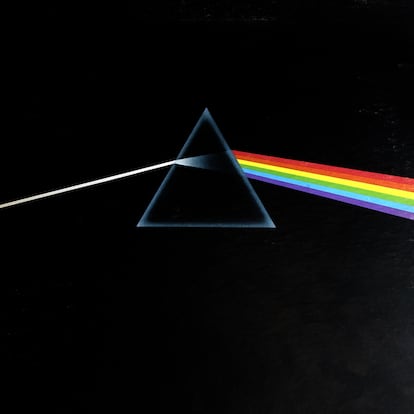50 years of ‘The Dark Side of The Moon’: The record about the tragedy of modernity that led to a schism in Pink Floyd
While they were recording this exquisite work—which continues to resonate today—enduring conflicts emerged. Now, Roger Waters intends to re-record the album without the other band members’ participation

Of all the arguments that Roger Waters and David Gilmour have had with each other during their long and checkered relationship, the one that developed during the recording of The Dark Side of the Moon must have been one of the mildest. But it was their first spat, and, to a certain extent, it gave rise to all the disagreements that came after. Nick Mason, the drummer of the British band, explains it this way in his book Inside Pink Floyd: “These were the first warning signs of fundamental disagreements within the group. Boundaries were being drawn as to what was and was not acceptable, indiscriminately and unintentionally, but they were being drawn.” What was the argument about? A technical matter: Waters wanted a dry sound, the one he later imposed on The Wall, and Gilmour preferred something thicker, grander and more reverberant. Apparently, Gilmour’s vision won out, a consolation prize on an album whose concept and lyrics were Waters’s own work. Thereafter, Waters no longer wanted anyone to challenge his imperious leadership of the four-man band.
This month, The Dark Side of The Moon turns 50 years old (it was released in March 1973). But the album’s current relevance isn’t just because of its half-century anniversary: in recent weeks, fights between Pink Floyd’s two leaders have flared up; it remains the third best-selling album in history (after Michael Jackson’s Thriller and AC/DC’s Back In Black); its sound and message are still relevant; the album is being re-released next week in a box set that includes a live performance from the era; and, most shockingly, Waters is re-recording the album without the band’s two surviving members who recorded the original version (drummer Nick Mason and guitarist and singer David Gilmour; keyboardist Richard Wright passed away in 2008 at the age of 65).
In 1973 Pink Floyd was at an important crossroads. It had released seven albums and overcome its first leader’s defection (Syd Barrett left in 1968, obviously suffering from mental problems), but the band had yet to find a sound that would take the group to the next level and give them decades-long staying power. At the time, Waters and Wright were 29 years old; Mason, 28; and Gilmour 26. “It’s a milestone in rock history; it holds the record for staying on the charts and allowed an independent band to achieve megastar status,” notes Jean-Michel Guesdon, the co-author of Pink Floyd All the Songs: The Story Behind Every Track.

The Dark Side of The Moon is a conceptual album born of Roger Waters’s concerns. Artistically, the work is tremendously ambitious, and it represents our great modern tragedy: it reflects on greed, the passage of time, mortality and mental health. Half a century later, the timeliness of the lyrics (all written by Waters) remains vibrant. “The message is as valid now as it was then. It speaks of modern man’s alienation. The concept is life, and that never goes out of style. It’s also important because it’s not an overly complicated album. It can be enjoyed as a collection of songs, because they are very good,” explains Mark Blake, the author of Pigs Might Fly: The Inside Story of Pink Floyd.
Pink Floyd began to perform the songs on the album on a flurry of tours, months before the band entered the recording studio, which is unthinkable in our current day of karaoke/concerts. This approach allowed the four band members to shape the songs and add or discard details; it also gave them a sense of the audience’s reaction to them. They continued to perform concerts and made stops at the Abbey Road Studios in London. It took about seven months from the time Pink Floyd started recording until they finished, but there were only 40 days of actual recording. A 25-year-old sound engineer named Alan Parsons, who had apprenticed with George Martin on the Beatles’ records, assisted with the recording. Three years later, Parsons would leave to start his own successful avant-garde career.
The album is replete with sonorous discoveries. Spanish guitarist Igor Paskual describes it this way: “Waters, Mason and Wright went to the School of Architecture at Regent Street Polytechnic College (there is even a plaque to indicate that). Their music is conceived in terms of planes, spaces and proportions. It seems like an ethereal, floating record, but like all architecture that seems spatial, its structures are very well built. Its foundations are based on drums, bass, rhythm guitar and keyboard, which are played and recorded all at the same time. It sounds amazing: it’s hard to distinguish among the instruments because of how well intertwined they are, the [sound] seems to be much greater than the sum of its parts. The keyboard sometimes sounds like a guitar and vice versa. The drums, for example, can be heard as a whole, unlike in today’s recordings, where you don’t hear the drums, but rather a bass drum, a snare or a cymbal.” Despite some differences of opinion, the group worked as a team and each band member contributed his energy to benefit the final product.

The album consists of 10 songs. It opens with “Speak to Me,” an instrumental piece that includes all the sound effects that appear throughout the album (each of which has its own meaning): a cash register, a heart beating, the hands of a clock, coins falling, the wail of a helicopter’s propellers, laughter... And a voice in the background sets the scene: “I’ve been mad for fucking years, absolutely years / Been over the edge for yonks, been working me buns off for bands...”. Then “Breathe” erupts with a beautiful steel guitar pedal, probably inspired by Neil Young songs. The pieces flow strung together, to facilitate a complete listening experience. Time is a highlight, especially because of Gilmour’s tremendous work, both singing and on guitar, throughout the recording. In “Money,” Waters decries the corrosive effect of lucre, but he would earn a lot of it precisely because of this album. It was the most played song of the album, the one that allowed The Dark Side... to sell millions of copies. “In Money’s guitar solo (in minute three of the song), the first part seems as if Gilmour is using a long brushstroke because his sound echoes. But, 50 seconds later, he removes the echo and makes the guitar [sound] dry; the notes are then short brushstrokes. Also, the band, right at that moment, turns down the intensity and builds a smaller room to accommodate the short brushstroke. First, [the album is like] Van Gogh and then [it’s] pointillist. [It’s] a masterpiece,” Pascual explains.
“Brain Damage” is about madness; it is Waters’s tribute to his friend Syd Barrett. “This album is the link between the British experiments of the 1960s and the advent of Radiohead,” says Paskual, who even sees the seeds of Detroit techno in the group’s instrumental “On the Run.” The album is not long (42 minutes), which is surely a function of the vinyl format’s capacity, and it is intended to be listened to in its entirety as an emotional journey. Each song leads smoothly into the next one; there aren’t any jolts. The goal of this journey is to lead somewhere, for each listener to find his or her own recreational space and enjoyment.
There are numerous anecdotes about the process of recording the album. The group handed out cards with difficult questions (when was the last time you hit someone? are you scared of death?) to those who swarmed the studio, from Paul McCartney, who was recording an album there with Wings, to the studio’s Irish doorman. Ultimately, the former Beatle’s answers were omitted “because they were too cold.” However, the doorman, named Gerry O’Driscoll, had the honor of closing the album. On “Eclipse,” the final piece, in addition to repeating the heartbeat with which the album opens, we hear a reflection by O’Driscoll: “In reality, there is no dark side of the moon: in fact, all of it is dark.” The band continues to filter the beats until they die out. One of the lessons from the album is that accepting mortality is inevitable and it’s a relief to move on. Another supporting character on The Dark Side of The Moon was Clare Torry, who provided the chilling vocals for “The Great Gig in The Sky.” The English singer charged only £30 for that session. After the album’s massive success, she sued the group asking for more money because she had created the melody to which she lent her voice. In 2005, she received that money. Since then, she has been credited for her vocal composition and receives payment for it.

The record’s extraordinary sales caught the musicians off guard, and each one dealt with the success as best he could. After all, it was an album that delved into somber themes and the disillusionment of the human condition, a topic that was unlikely to become a hit with the general public. But it did. “I think the success made everyone uncomfortable, especially Waters, who saw his socialist convictions at odds with his newly rich status. His behavior was affected: he took over the leadership of the group, which gradually led to the end [of Pink Floyd]; or, at least, the end of the group with him as a member of it,” explains Jean-Michel Guesdon. In interviews from that time, Waters, who left the band in 1985, acknowledged his dilemma: “I was a self-proclaimed socialist and now I had to choose between remaining one or looking at capitalism. And I chose the latter.” He has also acknowledged that it was “the beginning of the end of the group” because of his disagreements with Gilmour.
The prospect of a new version of the album recorded by Waters alone doesn’t inspire much excitement. “I don’t think it’s a good idea,” notes the author of Pink Floyd All the Songs: The Story Behind Every Track. “I’m curious to hear what this new version sounds like, but I’ve had my original copy for 45 years and it still works for me,” adds the author of Pigs Might Fly: The Inside Story of Pink Floyd.
After The Dark Side of The Moon, the same Pink Floyd quartet released Wish You Were Here (1975), Animals (1977) and The Wall (1979). They were monumental works (especially the first and third albums) that were created amid Waters and Gilmour’s continuous conflict, in other words, the albums were the felicitous products of leaving two narcissists in the same recording studio together.
Sign up for our weekly newsletter to get more English-language news coverage from EL PAÍS USA Edition
Tu suscripción se está usando en otro dispositivo
¿Quieres añadir otro usuario a tu suscripción?
Si continúas leyendo en este dispositivo, no se podrá leer en el otro.
FlechaTu suscripción se está usando en otro dispositivo y solo puedes acceder a EL PAÍS desde un dispositivo a la vez.
Si quieres compartir tu cuenta, cambia tu suscripción a la modalidad Premium, así podrás añadir otro usuario. Cada uno accederá con su propia cuenta de email, lo que os permitirá personalizar vuestra experiencia en EL PAÍS.
¿Tienes una suscripción de empresa? Accede aquí para contratar más cuentas.
En el caso de no saber quién está usando tu cuenta, te recomendamos cambiar tu contraseña aquí.
Si decides continuar compartiendo tu cuenta, este mensaje se mostrará en tu dispositivo y en el de la otra persona que está usando tu cuenta de forma indefinida, afectando a tu experiencia de lectura. Puedes consultar aquí los términos y condiciones de la suscripción digital.
More information
Archived In
Últimas noticias
New York enters the era of Zohran Mamdani
Welcome to the post-religion era: The idea of Christianity as the absolute truth has become obsolete
‘I thought you would like it’: The risky sexual practice popularized by TV shows and TikTok
The digitalization of tourism: ‘They promise experiences and gave us the worst possible one’
Most viewed
- Sinaloa Cartel war is taking its toll on Los Chapitos
- Reinhard Genzel, Nobel laureate in physics: ‘One-minute videos will never give you the truth’
- Oona Chaplin: ‘I told James Cameron that I was living in a treehouse and starting a permaculture project with a friend’
- Why the price of coffee has skyrocketed: from Brazilian plantations to specialty coffee houses
- Silver prices are going crazy: This is what’s fueling the rally











































